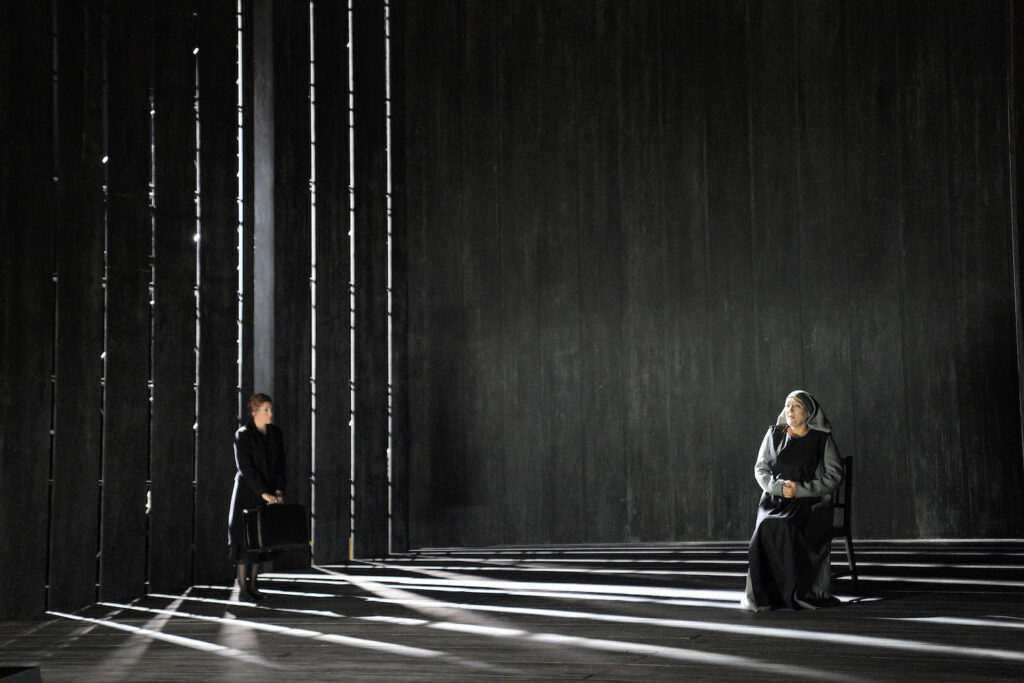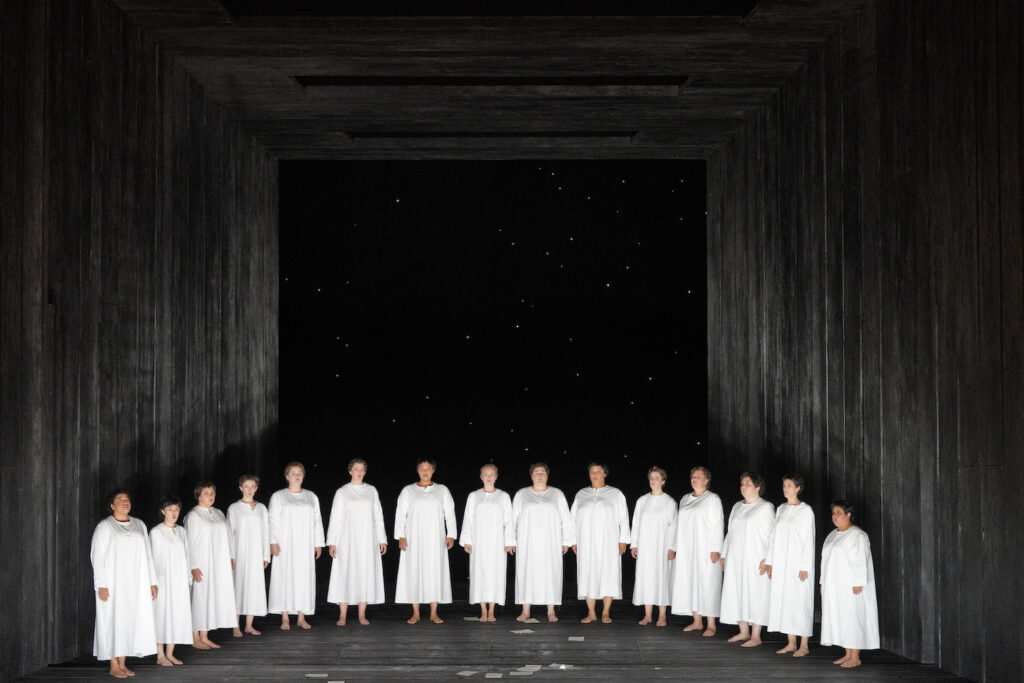Poulenc’s masterpiece (1957), Camus’ La Chute (The Fall) Nobel Prize for Literature (1957), Bernstein’s West Side Story (1957), Gian Carlo Menotti’s The Saint of Bleecker Street (1954).
San Francisco Opera has mounted just now French stage director Olivier Py’s 2013 production of Les Dialogues des Carmelites (Théâtre des Champs-Elysées then at Brussel’s La Monnaie [2017]), a staging that invokes the philosophical moods of the mid-1950’s as much as Poulenc’s music echoes the accessible, populist compulsions of the era.
Poulenc’s score is tonal, the story is told in recitative, the orchestration is sparse, transparent, descriptive and emotional. The libretto based on the novella of a German authoress of the late nineteenth century was a failed film scenario that was an elaboration of an actual historical incident (the decapitation of Carmelite nuns near the end of the Reign of Terror). Poulenc asked that the opera be sung in the vernacular of the theater, its La Scala premiere was in Italian, its American premiere a few months later at San Francisco Opera was in English. Following the Met’s lead (2013) San Francisco Opera has now rendered it in French, though there were no francophones in the cast to sing this French screenplay.
Olivier Py forsakes the bright tricolors of the French Revolution using instead a dark, empty theater, illuminated only by the usual “ghost light” — a single bulb mounted on a standing pole meant to dispel or maybe reveal the specters of the imaginary souls that have inhabited its stage. There is a wall that splits horizontally and vertically, partially and totally, to reveal from time to time massive, leafless/lifeless tree trunks. Ghostly stagehands are shadow puppets wielding props depicting death and destruction as needed.

All photos copyright Cory Weaver, courtesy of San Francisco Opera
Director Py and his designer Pierre-André Weitz have created a theater world that is dark and frightening, a theatrical world that is imaginary as well as real. It is a universal world of modern, maybe recent times. While Poulenc had recently re-embraced the Catholicism of his youth the opera is decidedly non-ecumenical, despite its trappings. Finding no meaning in this world the Carmelites renounce it, yet they fear leaving it. They overcome this fear, and thereby find meaning in this world. It is the existential dilemma, though it vaguely echos the Christian metaphor, present in the plethora of crucifixion images Mr. Py exploits.
Les Dialogues des Carmelites portrays a kind of matriarchal family, all of whose women are in the throes of spiritual crises. The nun Blanche de la Force bridges and confuses the menace of the outside world with the refuge of the convent. The old mother superior, hung on the wall like Jesus on the cross, begs that she not suffer, an image verging on blasphemy. The novice Constance confronts her own innocence, Mother Marie confronts her understanding of sacrifice, the new Mother Superior confronts her responsibility to her sisters.
In the Py production Poulenc’s kitsch guillotine finale assumes, potentially, a philosophic grandeur that overcomes the usual Guignol horror of the scene.
The Paris premier boasted the creme de la creme of French divas as its protagonists — Patricia Petibon, Sabine Devieilhe, Sophie Koch, and Veronique Gens. N.B. the only non-Francophone was Rosalind Plowright as the dying mother superior.
In San Francisco the role of Blanche de la Force was taken by Heidi Stober, San Francisco Opera’s go-to soprano for light lyric roles. Mme. Stober is an estimable artist who embodied Poulenc’s heroine with obvious conviction. Blanche’s brother, the Chevalier de la Force (Blanche’s secular world), was sung by Ben Bliss who possesses a voice of great beauty and a handsome bearing. Both Mme. Stober and Mr. Bliss were perhaps directed to illustrate the production’s theater metaphor (the production was staged in San Francisco by Daniel Izzo, an Olivier Py assistant} with exaggerated acting, in Mr. Bliss’s case however the acting verged on mugging.
The novice, Sister Constance, was effectively sung by soubrette Deanna Breiwick. Soprano Melody Moore enacted Mother Marie in large, warm tones that embodied her maternal and intellectual largesse, though her exclusion from her sisters’ martyrdom was compromised by the lightweight performance of the convent’s priest confessor — tenor Brenton Ryan (strange casting) had the daunting task of conveying God’s will. The young prioress, the role taken at the San Francisco Opera U.S. premiere by Leontyne Price, was sung by soprano Michelle Bradley whose arching vocal climaxes did not equal her otherwise exemplary performance, leaving her character somewhat pallid.
German soprano Michaela Schuster portrayed the dying prioress in huge gestures, making her fear of suffering the suffering of fear, though without a subtlety of intent. Mme. Schuster possesses a voice that at this point is more suited to her upcoming Herodias’ in Vienna.
Blanche de la Force’s father was gruffly sung by bass baritone Dale Travis. Mezzo soprano Catherine Cook had an impressive moment in the brief cameo role of Mother Jeanne.
San Francisco Opera music director Eun Sun Kim imposed a considerable presence for the San Francisco Opera orchestra, a presence that often competed with the stage for attention.

Former Adler Fellows Efrain Solis, Christopher Oglesby and Hadleigh Adams sang the smaller male roles. All of the Carmelite nuns were named roles, their quite beautiful chorales sung by Taylor Raven, Deborah Nansteel, Alexandra Sanchez, Esther Tonea, Chea Kang, Mikayla Sager, Gabrielle Beteag, Jesslyn Thomas, Anne-Marie MacIntosh, Elisa Sunshine, Buffy Baggott, and Courtney Miller.
The ghost lamp was hardly the only light. French lighting designer Bertrand Killy, the production’s original lighting designer, provided the needed illumination, a daunting task when the image is an empty, black stage.
Michael Milenski
War Memorial Opera House, San Francisco, October 18, 2022